 |
Tylosaurus proriger
A new record of a large mosasaur from the Smoky Hill Chalk
Copyright © 2000-2011 by Mike Everhart
Last updated 06/15/2011
LEFT: The skull of the Tylosaurus
proriger (FFHM 1997-10). The measuring stick is one meter in length
(39.37 inches). The skull is 49 inches long. |
| Things are often more complicated than they may
appear. I became involved in the recovery of this specimen after the
landowner discovered that it was being collected without his
permission. It was a sticky situation and feelings were hurt in the
process. Parts (the front limbs) are missing and probably beyond recovery.
A friend of mine was involved as a volunteer in the dig, assuming that
landowner permission had been obtained, and provides the
story of the initial stages of the dig on his website. |
In September, 1996, we removed the skull and seven cervical vertebrae of a very
large mosasaur from an exposure of the Smoky Hill chalk called Horse Thief Canyon, south
of Quinter, in Gove County, Kansas. The locality was near the site of Sternberg’s
famous "fish-in-a-fish" (Xiphactinus audax)
specimen and was from about the middle of the Smoky Hill Chalk member (middle Santonian
age, Late Cretaceous) of the Niobrara formation. The remains are approximately 85 million
years old. The picture at the top of this page shows the the right side of the skull
and cervical vertebrae as viewed in the field. Apparently, the skull came to rest in an an
upright position before slumping over on the left side. The right lower jaw came apart
prior to fossilization. The right quadrate and part of the right rear of the skull are
visible above the skull. Ribs and bones from the front limbs were also found in this area,
including several limb elements that were within the skull itself.
The skull was 4 ft. (1.2 m) in length and was found laying on its left side. It
was crushed laterally. Except for portions of the right lower jaw, the right quadrate, and
the right and left pterygoid bones that make up the hard palate in the roof of the mouth,
however, the skull was still articulated, and in excellent condition. The vertebrae of the
neck were still articulated and attached to the occipital condyle at the base of the
skull. Several ribs and limb bones were also recovered at the site.
Based on the size of the skull, the entire animal would have been about 30 ft.
(9+ m) in length. Evidence from the site indicated that at least some of the rest of the
specimen (20 ft.) might still be in place. From the size of the animal, it was almost
certain that it was a Tylosaurus, but the species was not positively determined
in the field. Tylosaurs are the largest of the three genera of mosasaurs commonly found in
the chalk, but supposedly only reached this size in the upper portions of the Smoky Hill
chalk. Many complete or nearly complete specimens of this species from Kansas are in major
museums around the world thanks to the efforts of early paleontologists such as Cope,
Marsh, and Sternberg.
Naming the first mosasaur from Kansas
As a bit of historical background, the type
specimen of Tylosaurus proriger (MCZ 4374) was discovered
near Monument Rocks in Gove County by "Col. Connyngham and Mr. Minor,"
and was
obtained by Professor Louis Agassiz during his 1868 visit to western Kansas. It was the
first mosasaur to be described from Kansas and was originally named “Macrosaurus” proriger by E. D. Cope. The
description of the new species by Cope (1869) in the
minutes of the Academy of Natural Sciences of Philadelphia meeting of June 1 was brief by modern standards:
“He [Cope] made some remarks on a fine fragment of the muzzle of a
large Mosasauroid, which pertained to a cranium of near five feet in length. The pterygoid
bones were separated from each other, and support nine teeth. A peculiarity of physiognomy
was produced by the cylindric prolongation of the premaxillary bone beyond the teeth, and
a similar flat prolongation of the extremity of the dentary. He referred the species to Macrosaurus Owen, under the name M. proriger.”
The following year, Cope
(1870, pl. 12, figs 22, 23) described the same specimen more completely, figured it
and, with little explanation, referred it to another European genus, Liodon Owen.
Two years later, O.C. Marsh, apparently recognizing significant differences between the
American and European mosasaurs, proposed a new genus (Rhinosaurus: meaning nose-lizard) from a more
complete specimen (YPM 1268 - Rhinosaurus micromus) he had collected ‘on the south side of the Smoky Hill
River’ in 1871. However, that name was preoccupied and Cope (1872) proposed
the genus name Rhamphosaurus. In a brief note, Marsh (1872b, p. 147) wrote that:
“As this name [Rhinosaurus]
proves to be preoccupied, it may be replaced with Tylosaurus. The name Rhamphosaurus, since suggested by Prof. Cope,
cannot be retained, as it was given to a genus of lizards in 1843 by Fitzinger.”
Leidy (1873, p. 274) was the first to place ‘Macrosaurus’
proriger Cope, 1869 into Tylosaurus Marsh.
That
said, Cope didn't give up.... In Cope's "Review of the
Vertebrata" paper (1874, p. 36), he wrote this disclaimer as part of
his description of a new species, Rhamphosaurus (Tylosaurus)
nepaeolicus: "This name was applied by Fitzinger to two species
of lizards, which had already received several generic names, and hence
became at once a synonym. Further, he did not characterize it; for these
reasons the name was not preoccupied at the time I employed it as above;
hence there is no necessity for Prof. Marsh's subsequent name Tylosaurus,
given on the supposition of preoccupation."
However, Marsh's name was accepted. A third species from the Smoky
Hill Chalk (Tylosaurus kansasensis) was named by Everhart
(2005). Several other tylosaurine mosasurs have been described from around
the world, including Antarctica. |
 |
LEFT: A drawing of the right side of a Tylosaurus proriger
skeleton (adapted from Russell, 1967), showing the elements found or accounted for as of
September, 1996. |
When the skull was turned over to expose the left side, initial
preparation showed that the left quadrate was complete and still articulated with the back
the skull and the left lower jaw. There were also indications of some soft tissue
preservation (cartilage) on the quadrate where the mosasaur's ear drum (tympanum) would
have been located. Further prep revealed that the sclerotic ring was intact and in place
where the left eye would have been. Apparently this is the first time that this feature
has been observed in Tylosaurs. Although one tooth was missing in the premaxilla, all
other teeth were present in the left maxilla (upper jaw) and dentary (lower jaw). There
are 15 teeth in each upper jaw and 13 in each lower jaw. The teeth are conical in shape
and the largest are about 2 inches high with a base that is about 1.5 inches across.
 |
LEFT: The left side of the skull after final preparation. The dark
color is the actual color of the specimen and makes photography difficult! The only
coatings used were Superglue (Paleobond) to preserve the teeth. Scale is 6 inches (15 cm). |
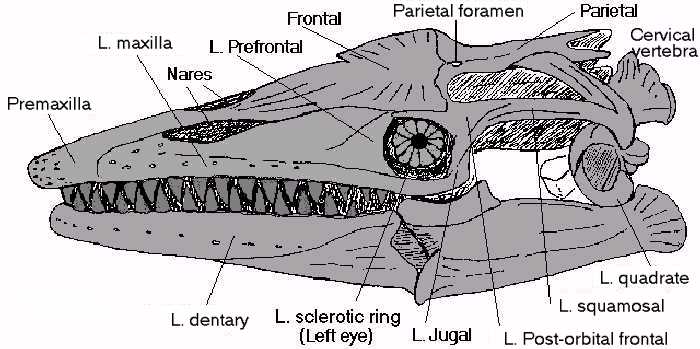 |
LEFT: A drawing of the left side of the skull after final
preparation. Because of distortion due to crushing during preservation, most of the top of
the skull (frontal and parietal) are visible along with all the elements of the left side. |
As the surrounding chalk matrix was removed, special attention was paid to the
characteristics of the quadrate, the joint between the pre-frontal and post-orbital
frontal bones over the eye, the location of the nasal opening (located above the suture
between the premaxilla and maxilla of the upper jaw), and the location of the parietal
foramen on the top of the skull. These are key characteristics in determining species in
tylosaurs.
 |
This is a lateral view of the left quadrate of the specimen.
Many of the characteristics of this bone are obscured by the preservation of the tympanum
(ear drum) in the center. Click here for a drawing of
the left quadrate of Tylosaurus proriger (adapted from Russell, 1967).
Additional pictures of this quadrate are shown HERE and
HERE. Although completely at home in the ocean,
mosasaurs had evolved from terrestrial lizards and certainly had a sense of hearing. |
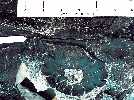 |
Tylosaurus proriger is the only mosasaur species in which
a forward projecting spur of the post-orbital frontal
actually overlaps the posterior edge of the pre-frontal
bone. In T. nepaeolicus, the post-orbital frontal and pre-frontal meet
over the orbit of the eye, but there is no overlap. In most other mosasaurs, the
post-orbital front and pre-frontal do not touch, and the frontal forms the upper part of
the orbit of the eye. |
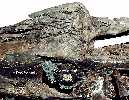 |
The parietal foramen in Tylosaurus proriger is relatively
small compared to other mosasaurs and located behind the suture between the frontal and parietal bones. In T. nepaeolicus, the parietal
foramen is larger and located several diameters behind the suture. |
 |
The location of the nares is a distinguishing characteristic
between Tylosaurus proriger and T. nepaeolicus. In most specimens
of Tylosaurus proriger, the opening of the external nares
begins at a point between the 5th and 6th tooth on the maxilla. In T.
nepaeolicus, the opening is begins above the fifth tooth.
In this specimen, however, the opening of the nares occurs between the fourth
maxillary tooth, possibly indicating that this is a transitional form. |
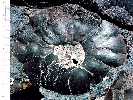 |
"Here's looking at you!"......a ring of bony plates
(sclerotic ring) that surrounded the left eye of this mosasaur. This is apparently a very
rare preservation in Tylosaurus. |
Gordon Bell (then at the South Dakota School of Mines) was contacted regarding
the identification of the specimen and, after reviewing the information, said that there
was no doubt that this was a Tylosaurus proriger. He also indicated that this
specimen would be a very early record for the species. A review of data provided by Bruce
Schumacher (also then at the School of Mines) on Kansas mosasaurs showed that there are no
records of this species in Gove County or from this low in the Smoky Hill Chalk. It
appears likely that this specimen is at least one million years older than previously
documented finds of Tylosaurus proriger.
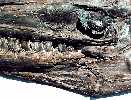 |
A view of the mid-portion of the left side of the
skull, showing the location of the sclerotic ring. The narrow finger of bone projecting
forward over the sclerotic ring is the anterior extension of the post-orbital frontal
(POF). This is one of the key characteristics that makes this specimen a Tylosaurus
proriger. In most mosasaurs, the POF barely contacts the prefrontal. In some genera,
such as Clidastes, the POF and prefrontal are widely separated, and the frontal
itself forms a bony ridge over the eye socket. In Tylosaurus proriger, the POF
overlaps the prefrontal and may have provided additional strengthening of the skull |
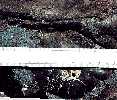 |
A close-up view of the anterior extension of the
post-orbital frontal over the orbit of the eye. |
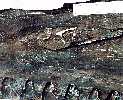 |
The left exterior nasal opening of the mosasaur's
skull. Although well adapted to marine life, mosasaurs were still air breathers and
probably breathed through their nasal openings when they surfaced. |
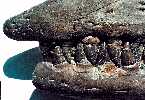 |
The business end of a mosasaur, showing the extension
of the premaxilla over the most anterior teeth which is also typical of Tylosaurs. The
large premaxilla is often assumed to have been used as a 'battering ram' but this appears
to be highly unlikely. The joint between the premaxilla and maxilla is shown between the
second and third teeth on the upper jaw. Pits shown in the upper and lower jaws are
probably openings for blood vessels and nerves. |
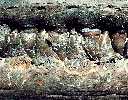 |
The middle teeth in the upper and lower jaws.
Although shaped like sharp cones, the teeth do not have much of a cutting edge. In
most mosasaurs, the teeth were used primarily for seizing and crushing prey, which was
then swallowed whole. |
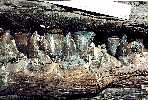 |
The posterior teeth in the upper and lower jaws.
|
 |
The discovery of the specimen was dramatized in a documentary filmed for the Paleoworld series on the Discovery
Channel. Unfortunately, the series was cancelled in mid-season and the documentary was
not shown in the United States. It has been shown on various television networks around the
world, including the Philippines. On April 19, 1997, the specimen was
donated by the land owners to the Fick Fossil
and Historical Museum in Oakley, Kansas where it will be on permanent display. It was
later filmed by a movie crew from Australia, but the footage was later cut from the
documentary. A photo of me with the specimen is HERE.
On October 11, 1997, the specimen was reported at the 57th annual meeting of
the Society of Vertebrate Paleontology in Chicago, IL. The published abstract for that
presentation is shown below: |
Everhart, M. J. and P. A. Everhart. 1997. Earliest occurrence of the mosasaur, Tylosaurus
proriger, (Mosasauridae: Squamata) in the Smoky Hill Chalk (Niobrara Formation, upper
Cretaceous) of western Kansas. Jour. Vert. Paleon. 17(Supplement to 3):44A.
In 1996, the articulated skull and seven cervical vertebrae of a large (10 m)
mosasaur were collected from the middle of the Smoky Hill Chalk member of the Niobrara
Chalk (Upper Cretaceous) in Kansas. Stratigraphically, the remains were found 2.7 m. below
the base of Marker Unit 10 and within the upper portion of the biostratigraphic zone of Clioscaphites
vermiformis. The site is middle Santonian age and is dated at about 85 mya. The
specimen was identified as Tylosaurus proriger on the basis of the following
characters: the lateral overlap of the prefrontal by the post-orbital frontal, the large
infrastapedial process of the quadrate and the location of the parietal foramen. The
length of the skull (1.2 m) was also a key identifying factor since no other mosasaur of
this time was as large. The slightly more anterior location of the nares, compared to
other specimens of T. proriger, is a condition that is probably transitional from
T. nepaeolicus. T. proriger has not been previously reported from lower than
Marker Unit 15. This new specimen extends the temporal range of this species in the
Western Interior Sea by at least 1.5 million years and further defines the ecological
diversity of the seaway during the deposition of the Smoky Hill Chalk.
Samuel W. Williston's Tylosaurus
proriger .
Line drawings from Volume IV of the University Geological Survey
of Kansas, published 1898
The Dig Continues - New Field Work - May
2-4, 1997
We Finally Complete the Dig......June 28,
and August 7-8, 1997
Credits: The drawings of the Tylosaurus proriger
skull and skeleton were adapted from Systematics and Morphology of American Mosasaurs,
by Dale A. Russell, pgs 173 and 238, Peabody Museum of Natural History, Yale University
Bulletin 23, 1967.

















